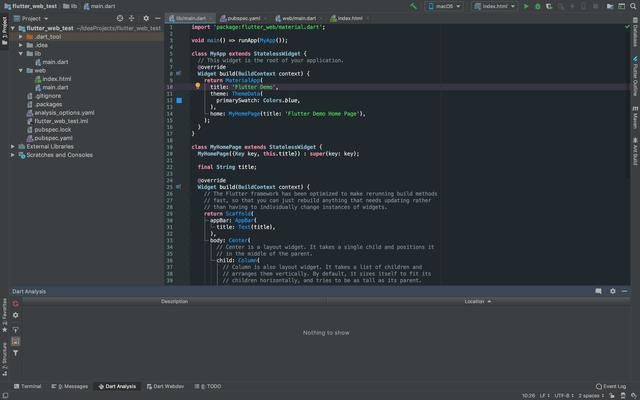众所周知Google对于Flutter的期望是全平台统一UI开发,号称要做一套“一份代码、全平台部署”的UI框架,这一点在移动端已经很成熟了,国内有很多成功的案例,典型的像阿里的闲鱼客户端,但是Flutter所声称的桌面端和Web端的相关案例还很少,之前我写过一篇文章介绍如何将Flutter代码部署成为桌面端程序,那么本文就该介绍如何将Flutter部署为Web应用了。
本文将会以一个实例来带大家一步一步探寻如何将Flutter应用程序部署到web端,我们先来看一下最终的效果:
可以看到,就是一个简单的登录界面,没有太复杂的逻辑,旨在帮助大家走通Flutter部署到Web端的流程,至于实际的应用场景大家可以根据自己的需要自行开发。
开发环境配置
Flutter 1.5及更高的版本才支持Web端部署,这主要指的是将Dart编译为JavaScript,所以,必须要确保我们本地的Flutter SDK的版本在v1.5.4以上,建议直接使用命令flutter upgrade更新到最新版即可。
安装flutter_web编译工具
要想将Flutter代码编译为Web端可部署的应用程序,必须安装flutter_web,这是一个Flutter官方为我们开发并维护的编译工具,直接使用以下命令安装即可:
flutter pub global activate webdev
安装完成后,需要配置环境变量,直接将$HOME/.pub-cache/bin加入到你的环境变量中即可,由于电脑不同的操作系统配置环境变量的方式不同,这里就不一一展开赘述了,以mac操作系统为例:
cd
vim .bash_profile
然后添加一行:
export PATH="$PATH":"$HOME/Flutter/flutter/.pub-cache/bin"
退出并保存,使用如下命令使其生效:
source .bash_profile
至此,我们的开发环境就搭建好了,可以看出,只要我们本地的Flutter环境配置的没有问题,配置Flutter for web只是多装了一个flutter_web编译工具而已,非常简单。
创建项目
区别于普通的Flutter项目,由于Flutter对web的支持目前还没有完全完成,相当于是一个供大家尝鲜的作品,所以创建Flutter for web项目和普通Flutter项目不一样,这里建议大家使用idea,我这里也以idea为例进行说明:
创建Dart项目,而不是Flutter项目
直接在Idea中新建项目,如下图所示:
注意三点:
- 选择Dart项目,而不是新建Flutter项目
- 正确设置自己dart sdk的位置
- 选择Generate sample content中的Flutter Web App选项
创建完成后我们的项目就默认支持部署到Web了,在Idea中应该可以直接点击运行按钮进行运行,或者可以在Idea的终端中输入:
wevdev serve
进行运行,初次编译可能会下一些本项目所依赖的包,需要一分多钟,后面编译会快很多,编译完成后会弹出一个浏览器的窗口(注意,这里建议使用Chrome浏览器,其他浏览器笔者没有测试过,按照官方的说法,目前支持最好的应该是Chrome浏览器)如下图:
我们来看看项目结构:
可以看到,大体的项目结构了普通的Flutter项目差不多,知识多了一个web文件夹,下面是一些和web相关的文件和资源,后面我会具体讲其用处。
编写代码
创建好项目之后,我们就可以着手代码的编写了,这里不再详细叙述代码怎么写,和普通Flutter编写代码的规则是一模一样的,这里我在lib文件夹下新建了一个pages文件夹,然后新建了login_page.dart文件,编写登录界面的代码,完成后代码如下:
import 'package:flutter_web/material.dart';
class LoginPage extends StatefulWidget {
@override
State createState() => new _LoginState();
}
class _LoginState extends State {
static final GlobalKey _scaffoldKey =
new GlobalKey();
final TextEditingController _phoneController = new TextEditingController();
final TextEditingController _passwordController = new TextEditingController();
bool _correctPhone = true;
bool _correctPassword = true;
bool showProgress = false;
void _checkInput() {
if (_phoneController.text.isNotEmpty) {
_correctPhone = true;
} else {
_correctPhone = false;
}
if (_passwordController.text.isNotEmpty) {
_correctPassword = true;
} else {
_correctPassword = false;
}
setState(() {});
}
_handleSubmitted(int flag) async {
/**
* flag=0:管理员登录
* flag=1:用户登录
*/
_checkInput();
if (!_correctPassword || !_correctPhone) {
return;
}
}
@override
Widget build(BuildContext context) {
return new Scaffold(
key: _scaffoldKey,
resizeToAvoidBottomPadding: false,
body: new Stack(children: [
new Container(
decoration: new BoxDecoration(
image: new DecorationImage(
image: new AssetImage('images/bg.jpeg'),
fit: BoxFit.cover)),
),
new GestureDetector(
onTap: () {
FocusScope.of(context).requestFocus(new FocusNode());
},
),
_buildLogInWidgets(),
]));
}
_buildLogInWidgets() {
Color mainColor = Colors.black;
return new Column(
mainAxisAlignment: MainAxisAlignment.spaceEvenly, //垂直方向对其方式
crossAxisAlignment: CrossAxisAlignment.start, //水平方向对其方式
children: [
Center(
child: new Container(
child: Center(
child: new CircleAvatar(
backgroundImage: AssetImage("images/iron_man_icon.png")),
),
),
),
new Center(
child: new Container(
width: MediaQuery.of(context).size.width * 0.5,
child: new Column(
mainAxisAlignment: MainAxisAlignment.center,
crossAxisAlignment: CrossAxisAlignment.center,
children: [
new Container(
padding: const EdgeInsets.only(top: 32.0),
child: new TextField(
style: TextStyle(color: Colors.black),
cursorColor: mainColor,
controller: _phoneController,
keyboardType: TextInputType.text,
decoration: new InputDecoration(
hintText: '用户名',
hintStyle: TextStyle(color: mainColor),
errorText: _correctPhone ? null : '用户名不可为空!',
errorStyle: TextStyle(color: Colors.teal),
icon: new Icon(Icons.people, color: mainColor),
focusedBorder: UnderlineInputBorder(
borderSide: BorderSide(color: mainColor)),
enabledBorder: UnderlineInputBorder(
borderSide: BorderSide(color: mainColor)),
errorBorder: UnderlineInputBorder(
borderSide: BorderSide(color: mainColor)),
),
onSubmitted: (value) {
_checkInput();
},
),
),
new Container(
padding: const EdgeInsets.only(top: 32.0),
child: new TextField(
style: TextStyle(color: Colors.black),
cursorColor: mainColor,
controller: _passwordController,
obscureText: true,
keyboardType: TextInputType.text,
decoration: new InputDecoration(
hintText: '密码',
hintStyle: TextStyle(color: mainColor),
errorText: _correctPassword ? null : '密码不可为空!',
errorStyle: TextStyle(color: Colors.teal),
icon: new Icon(Icons.lock_outline, color: mainColor),
focusedBorder: UnderlineInputBorder(
borderSide: BorderSide(color: mainColor)),
enabledBorder: UnderlineInputBorder(
borderSide: BorderSide(color: mainColor)),
errorBorder: UnderlineInputBorder(
borderSide: BorderSide(color: mainColor)),
),
onSubmitted: (value) {
_checkInput();
},
),
)
]),
),
),
new Center(
child: new Column(
children: [
new Container(
width: MediaQuery.of(context).size.width * 0.2,
child: new Material(
child: new FlatButton(
child: new Container(
child: new Center(
child: new Text(
"登录",
textScaleFactor: 1.5,
style: new TextStyle(
color: Colors.white, fontFamily: "Roboto"),
)),
),
onPressed: () {
_handleSubmitted(0);
},
),
color: Colors.teal,
borderRadius: BorderRadius.circular(10.0),
elevation: 5.0,
),
),
new Center(
child: Container(
margin: EdgeInsets.only(top: 20),
child: new FlatButton(
child: new Text("没有帐户? 注册",
style: new TextStyle(color: Colors.teal)),
),
)),
],
)),
],
);
}
}
可以看到,代码和普通Flutter代码是一样的,只是需要注意以下几点:
包的使用
细心的同学可能会发现,我们这里导入的包是:
import 'package:flutter_web/material.dart';
而普通Flutter项目导入的是:
import 'package:flutter/material.dart';
原则就是原来的 package:flutter 改为 package:flutter_web ,原来的 dart:ui 改为 package:flutter_web_ui/ui.dart,当然,这些你只需要知道就好了,实际生产的时候直接快捷键按下,编辑器会自动帮我们导入正确的包。
资源的使用
我们之前使用资源文件(比如图片)的方式是在根目录下新建一个资源文件夹,然后将资源文件放在资源文件夹下,然后在pubspec.yaml文件中进行文件路径的声明,然后就可以使用了,在Flutter for web中,我们需要将原来的资源文件夹从之前的项目根目录迁移到web文件夹下,就像这样:
然后就可以正常使用了,这也是迄今为止我发现的Flutter for web和普通Flutter项目的不同之处了。
编写完布局文件后我们将main.dart稍作修改,引入我们的LoginPage:
import 'package:flutter_web/material.dart';
import 'package:flutter_web_demo/pages/login_page.dart';
void main() => runApp(MyApp());
class MyApp extends StatelessWidget {
// This widget is the root of your application.
@override
Widget build(BuildContext context) {
return MaterialApp(
title: 'Flutter Demo',
theme: ThemeData(
primarySwatch: Colors.blue,
),
home: MyHomePage(title: 'Flutter Demo Home Page22'),
);
}
}
class MyHomePage extends StatelessWidget {
MyHomePage({Key key, this.title}) : super(key: key);
final String title;
@override
Widget build(BuildContext context) {
return Scaffold(
body: LoginPage());
}
}
然后我们就可以运行起来看效果了:
和开篇的效果图一样,不再赘述。
总结
本文我们通过一个简单的实例带大家走了一遍Flutter在web端部署的流程,可以看到,目前Flutter在Web上的部署已经没有任何压力了,只是由于生态还不完整,很多库和包还不能用,所以目前还无法投入商用软件中,希望Flutter可以发展的越来越完善。同时,结合笔者个人的开发经验,建议大家开发Flutter项目时一定不要怕麻烦,多用像mvp这类的项目结构,这样可以大大提高开发效率。
如果你喜欢 Flutter ,想自己尝试一下的话,我收集了很多flutter的资料可以免费分享给大家!需要资料的小伙伴们可以加我的技术交流分享qq群:825106898。








